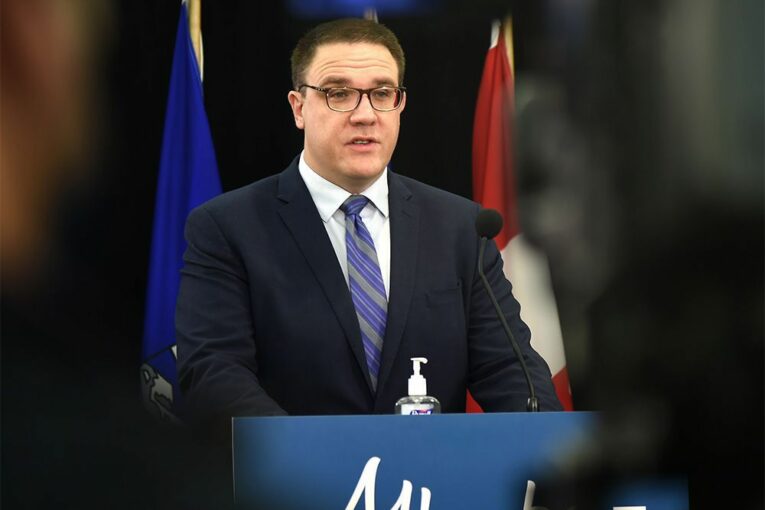
Consider Tuesday’s budget surplus in Alberta an appetizer served before a much bigger main course.
An unprecedented wave of resource revenue flooded into provincial coffers during the final months of the 2021-22 financial year, which ended March 31.
It allowed Alberta to declare its first budget surplus since 2015.
However, if today’s sky-high energy prices hold, the $3.9 billion surplus will be a preview to a much bigger bonanza set to arrive as windfall oil and gas revenues flow into the provincial treasury in the new budget year.
“The big question is what we do with the surplus this year, which could easily be in the double digits, in terms of billions of dollars,” said University of Calgary economist Trevor Tombe.
“You are looking at a $16 billion to $18 billion (surplus) for 2022,” added Peter Tertzakian, deputy director of ARC Energy Research Institute.
“Resource revenues are going to be just through the roof.”
On Tuesday, Finance Minister Jason Nixon released year-end results for the 2021-22 financial year that included an unexpected surplus, instead of the $3.4 billion deficit projected three months ago.
Alberta’s change in fortunes came from the revenue side as energy markets and the economy took off.
Total government revenues clocked in at a record $68.3 billion, more than 55 per cent higher than initial forecasts — or nearly $25 billion above projections.
Global oil prices climbed throughout last fall and topped US$100 a barrel following the February invasion of Ukraine by Russia.
Resource revenue hit an all-time record of $16.2 billion for the year, a stunning $13.3 billion above the budget estimates. It shattered the previous high-water mark set 15 years earlier.
With five oilsands projects reaching a higher “post-payout” royalty rate in 2021, total bitumen revenues contributed $11.6 billion to that mix.
“Clearly, if you look at what has taken place over the last year, it emphasizes what comes with an economy and a budget that depends on resource revenue. It could change very, very quickly,” Nixon said in an interview.
“The government is dedicating itself (to) not be on the rollercoaster and instead to be more strategic with these large windfalls and resource revenue.”
When the 2021 budget came out more than a year ago, the province was still recovering from the economic impact of the COVID-19 pandemic and a drop in commodity prices.
At that time, the province forecast benchmark West Texas Intermediate (WTI) crude prices would average a paltry US$46 per barrel for the fiscal year.
Instead, oil prices came in at $77 a barrel.
On Tuesday, WTI prices closed at $111.76 a barrel.
Alberta natural gas prices also exceeded expectations; gas royalties increased to $2.2 billion, reaching its highest level in a dozen years.
“Alberta was right not to give up on our largest industry,” Nixon said.
While higher energy prices powered much of the fiscal turnaround, other areas of the economy strengthened.
As more people went back to work and corporate profits increased, income tax revenues to the province exceeded expectations.
The province also reported a $2 billion gain from the partial reversal of a previously expected loss tied to contract provisions surrounding the Sturgeon Refinery.
With a surplus in hand, the province paid down $1.3 billion in debt last year, Nixon noted. Alberta’s total taxpayer-supported debt now sits at $93 billion.
“We have a much smaller debt than other provinces,” said Alberta Central chief economist Charles St-Arnaud, noting 23 per cent of provincial revenues came from resource royalties.
“But we’ve seen in previous years what happens to our fiscal situation when oil prices come down.”
Provincial spending was also up $2.5 billion from last year’s budget. More money was directed to pandemic-related expenditures, as well as for disasters and emergencies.
The total market value of the Alberta Heritage Savings Trust Fund increased to a record $20 billion. It will likely increase in the coming year as the UCP government intends to put a portion of future surpluses into the rainy-day fund.
Nixon did not say how future surpluses might be split up between debt repayment, savings, or offsetting the impact of rising expenses for Albertans.
“I’m taking some of this as a cautionary tale of how quick things can swing and so we want to make sure that we’re putting our province in the best spot to respond to it,” he added.
“We’re also seeing unprecedented situations in regards to inflation.”
There will be pressure to spend more to buffer Albertans from consumer prices climbing at their fastest rate since the 1980s.
“Oil and gas revenues are very high, but the question is whether the province is using this money to improve the lives of Albertans,” said NDP MLA Shannon Phillips in a statement.
Expect the debate to grow in the coming months as royalty revenues grow.
Tertzakian noted resource revenue jumped in the last financial year as higher commodity prices took hold and more oilsands projects moved into a higher royalty tier.
Even if oil prices dropped to $65 a barrel, the province will be looking at resource revenues of about $10 billion a year “on a steady state basis,” he estimates.
Tombe expects resource revenues could hit $25 billion or more this year if oil stays above $100 a barrel.
Such a boon sparks questions about the best way to manage surpluses in the coming years, such as socking away money in the Heritage Fund, increasing spending or chipping away at debt.
“This tells us that the province’s finances are as tied as ever to world oil prices,” Tombe concluded.
“The really massive windfall that we’re going to see this fiscal year provides us, as a province, the opportunity to ease off the rollercoaster for the first time in a half-century…and save them in a really big way.”
Chris Varcoe is a Calgary Herald columnist.
You can read more of the news on source
